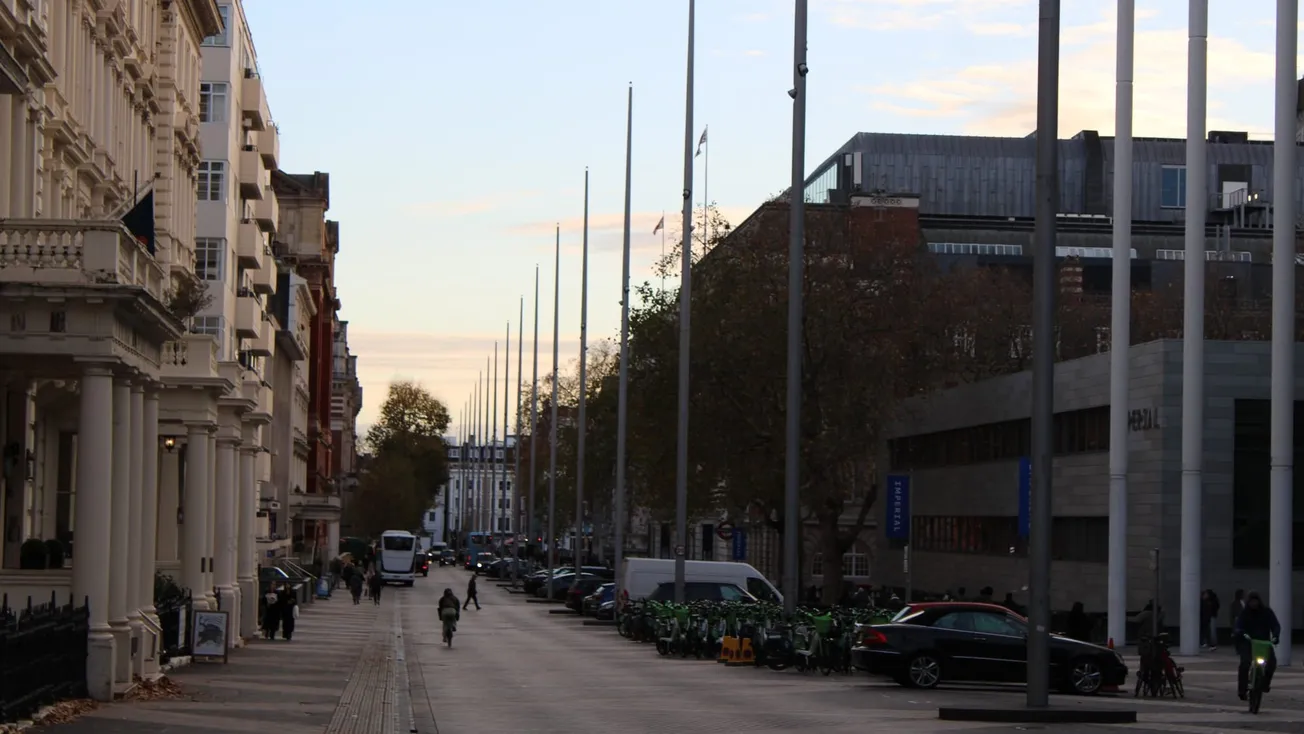Dear Londoners — summer is officially here — and so is the sun. Are you a hot weather proponent? I've always been a fan of high temperatures in June, as long as it still goes cool at night; it's the never-diminishing heat of August that feels unbearable. Either way, don't put your sunscreen away just yet, as it's going to climb to 30 degrees again the coming weekend. Good thing we've got a recommendation for the perfect al fresco wine spot below...
— Hannah, editor
Sign up to our mailing list to get two totally free editions of The Londoner every week by signing up to our regular mailing list. Just click the button below. No cost. No gimmicks. Just quality local journalism.
Get ready for the heat with our Londoner summer discount. For just £4.95 a month for your first three months, you can read this story — and the rest of our members-only content. That's a nearly 50% saving, meaning you can treat yourself to one more spritz, guilt-free. Act fast though, it can't stay forever.
Big story: Is Notting Hill Carnival at risk of a deadly crowd crush?
Top Line: Notting Hill Carnival could be facing closure in future after organisers said the cost of dealing with “critical public safety concerns”, including a potential deadly crowd crush, were impossible to afford without government support. But is this a real threat, or are concerns being exaggerated in order to shut down the festival?
The end of the carnival?: Last week, a letter to the culture secretary by the carnival’s chair, Ian Comfort, was leaked, in which he warned that an internal review had identified major safety concerns around the festival that needed to be addressed. Yet simultaneously, he explained, shortfalls in City Hall and Met police budgets meant their preparedness to send stewards and police officers to oversee the event as they had in the past was waning. As a result, an injection of government money was “essential” to safeguard the event’s future.
Background: In recent years, the Notting Hill Carnival has been a victim of its own popularity. Some two million people attended last year’s festivities as it increasingly shifts from a beloved event for the city’s Caribbean community to one attended by people all over the capital — and even further afield. With that record attendance, fears have grown that a lack of crowd management for such a humongous number of people could lead to a deadly crowd crush. Sadiq Khan even told a mayor’s question time event that the risk of a mass casualty event at the festival made him “frightened”. The Londoner spoke to experts in crowd science to try and get to the bottom of whether those fears were realistic, and what could be done to deal with to keep the festival alive.
Is it dangerous?: Dr G Keith Still, who advises officials and police including the Met on crowd management, claimed there are serious issues with pinch points around the festival — the constrained spaces where open air crowds become densely packed. He told The Londoner those risks weren’t being properly addressed by organisers, who lacked a proper crowd control plan, instead relying on piecemeal solutions and leaving much of the responsibility for controlling the event to the police. “Without that wider plan, small things that can go wrong can cascade and cause larger, significant issues,” he said, citing the crowd crush at open air Halloween celebrations at Itaewon in Seoul, South Korea, that left over 150 people dead in 2022.
Do the Met want it shut down?: “While I’m sure there are genuine issues with crowd safety, I have the feeling the Met are exaggerating their concerns about it because there is a bigger issue of resourcing,” Dr Chris Cocking, a lecturer in social psychology at the University of Brighton and an expert in crowd science, told us.
The Met deploys some 7,000 officers each day during the festival and spends upwards of £11m in total on policing it. At a time when they are recording a huge deficit and making sweeping job cuts, you could see why stopping costly events like Notting Hill Carnival may appeal to police leadership. “The Met have never liked doing Notting Hill Carnival. It’s a massive drain on their resources and one of the biggest ongoing operations they do. If they were given a choice I’m sure they’d rather it didn’t go ahead,” continued Cocking.
Is the answer to do less?: On the surface, the solutions that are often floated seem dramatic (and costly). Fencing off parts of the event, deploying a horde of stewards or ticketing to limit attendees would not only require more money and resource, but would be anathema to the free-spirited nature of the carnival — as would moving it away from its historic West London home, as has been suggested in the past.
But Cocking argues that crowds are actually very good at “self-governing”. The key is to try and shape how people act — through behavioural cues like one way systems or changing parade routes — rather than trying to directly control nearly two million people. “The idea that a mass casualty event is likely because there’s two million people on the streets of London and they can’t be safely managed is nonsense,” he added. “Crowd crush events are entirely preventable if there are effective and proactive crowd-safety management procedures in place.”
Your news briefing
🚇 TfL have launched a consultation on a planned extension of the DLR. The plans would see the Beckton branch of the line stop at Beckton Riverside before crossing the river to Thamesmead in Southeast London, with room for the line to continue growing after that. Given demands for central government funding for the plans — and indeed any other London infrastructure projects — were ignored at the spending review earlier this month, this new consultation seems likely to be a way to keep pressure on Westminster until it shifts its stance.
🎻 What’s the most expensive thing of yours that’s gone missing at the pub? Back in February, a member of the London Philharmonic Orchestra was enjoying a pint in the the Marquess Tavern in Islington when they realised their violin, made in the 18th century and worth a staggering £150,000, had been swiped. The police have now released images of the suspect in a public appeal over the case that was covered by RTÉ.

⚽ A historic leisure centre in Northwest London is fighting plans for its closure. According to the Guardian, the Bridge Park complex — a major hub for the Windrush generation and more recently used by a young Raheem Sterling — is set to be shuttered after the council decided the £1mn price tag for necessary refurbishment was too high. Now, locals are appealing to Historic England to help save the site, with just weeks left before it has to close.
🪦 At £5,449, the average cost of a funeral in the capital is the highest anywhere in the country, reports the BBC. The piece features some pretty depressing practical tips on how to “reduce costs” when a loved one dies, including cardboard coffins and not hiring a priest or celebrant.
🚲 Actress and icon Joan Collins has waded into the neverending debate on the capital’s Lime bikes, with the 92-year-old former Dynasty star decreeing the shoddy, pavement-blocking parking of the company’s users “loutish”.
Got a story for us to look into? Please get in touch.
If you missed it
Last week’s stories:
- Harry Shukman went undercover to investigate the Basketweavers, a network of far-right extremists that are largely composed of the capital’s young, white-collar workers. What has caused the group to see a boom in its numbers?
- In our latest culture edition, we covered the artists being touted as the future of the capital’s art scene, a sub-par East London music festival and the newly pieced together Roman fresco buried deep below an ancient villa in Southwark.
- Ever wondered how life in London differs from the Vatican? Well, for our ongoing ‘My first year in London’ series we spoke to Father Andrea Fulco, who moved to London from the papacy to become the priest of St Peter’s, Farringdon.
Wining and dining
With endless offerings and non-stop openings, we all know that deciding where to eat and drink in the capital can be fraught. We want to make it easy — so every week we’ll give you our insider guide to the city’s best spots.
One perfect meal: The received wisdom is that there is only one cuisine that London simply cannot do well: Mexican. While this was true up until fairly recently, the reign of flabby tortillas and melted cheddar is now firmly over, and over the past few years it’s become easier and easier to find excellent taquieras dotted around the capital. One such establishment is La Chingada, which set up shop in Surrey Quays in late 2019 and now boasts two more locations in Bermondsey and, perfect for those of you travelling up north, Euston.
All of the locations are endearingly gaudy — neon lights, plastic tables and murals painted almost exclusively in primary colours — although the Euston branch is the most sit-down-sophisticated of the three. It’s the kind of place that doesn’t take its ambience too seriously, the kind where you eat messily and laugh loudly and slurp your michelada with aplomb. But it isn't messing around when it comes to its food: think perfect, fall-apart al pastor tacos or zocalo corn, almost impossible to find in the UK, with chilli, lime and queso fresco.
Enjoying this edition? You can get two totally free editions of The Londoner every week by signing up to our regular mailing list. Just click the button below. No cost. Just old school local journalism.
One perfect drink: Covent Garden is a tricky part of town. These days, it’s mostly the domain of tourists — hyped-up on Ladurée macarons, wielding their Glossier shopping bags like weapons — and the pubs are almost all £7-a-pint chain outfits. But oddly, what the area does excel at is wine. In under a half-mile, there’s some of the city’s best spots: Bedford Street Wines, the 10 Cases, Monmouth Street Wines, La Compagnie, Le Beaujolais. For our money, the best is Lady of the Grapes, a tiny enoteca tucked away from the crowds on Maiden Lane.

Inside, the vibe is intimate, with low lighting, claret-coloured walls and taper candles, and its size means patrons sit elbow-to-elbow at antique wood tables, resulting in a sense of continental bonhomie (and an excellent chance for some eavesdropping). Lady of the Grapes really comes into its own in summer, though, when the pedestrianised street outside is thronged with tables (these can be — and often are — booked in advance, so clinching a walk-in is a matter of timing and sheer luck) and you can watch the evening sun slip below the townhouses.
As for what’s actually available, the by-the-glass wine list is extensive yet uniformly excellent and, with the house white and red starting at £8, fairly reasonable, particularly in this bit of the capital — we love a crisp Gavi at this time of year.
Our favourite reads
In London and Paris, we’ve experienced vicious backlash to climate action. But we’re not backing down — Sadiq Khan and Anne Hidalgo, Guardian
The London mayor is joined by his Parisian equivalent for a joint opinion piece on the online disinformation campaigns fuelling opposition to their cities' car reduction policies. In Paris, Hidalgo argues, this was seen in the controversy over projects such as pedestrianising the banks of the Seine, while in London it’s been the conflict over Ulez. Now, “We are calling on national governments, journalists, educators and tech companies to step up,” the mayors say.
How our gentrified London flat turned into a Hitchcockian nightmare — Yoel Noorali, Financial Times
Yoel Noorali has a problem: huge numbers of pigeons keep dying on the roof of his Peckham apartment block, and removing the bodies is becoming a problem. But why are they all there, what’s killing them and, most importantly, how do you get it to stop? By way of conspiracy, academia and a large rented hawk, Noorali sets out on a journey to find out the truth.
To Do List
- Sick of the stuffy Mayfair art world? Get down to Croydon’s Whitgift shopping centre on Saturday for the opening event of Hardcore/Love. Hosted by Conditions, a low-cost studio programme for artists, the exhibition is a screening of Arthur Jafa’s ‘Love is the Message, The Message is Death’ (2016) and Mark Leckey’s ‘Fiorucci Made Me Hardcore’ (1999) — two of the most influential moving-image artworks of the last half a century.
- The BFI’s new season dedicated to visionary actor, director and writer, Barbara Loden, means that there’s finally a chance to see a restored 35mm print of her 1970 classic Wanda, about an apathetic coal miner’s wife who goes on the run with a bank robber. The rest of the season is well worth checking out too — particularly the screening of Nina Menkes’ Queen of Diamonds.
From the archive
Filmmaker Jack Wormell courtesy of Barbican Centre on YouTube
This “archive mixtape” from the Barbican tells the story of the iconic estate through an eclectic compilation of stitched together videos. It starts with an old man talking about how ugly he finds the estate and only gets more entertaining (and unhinged) from there.
A fan of our Monday briefings? Get them for free each week by signing up to The Londoner mailing list below.

Comments
How to comment:
If you are already a member,
click here to sign in
and leave a comment.
If you aren't a member,
sign up here
to be able to leave a comment.
To add your photo, click here to create a profile on Gravatar.







